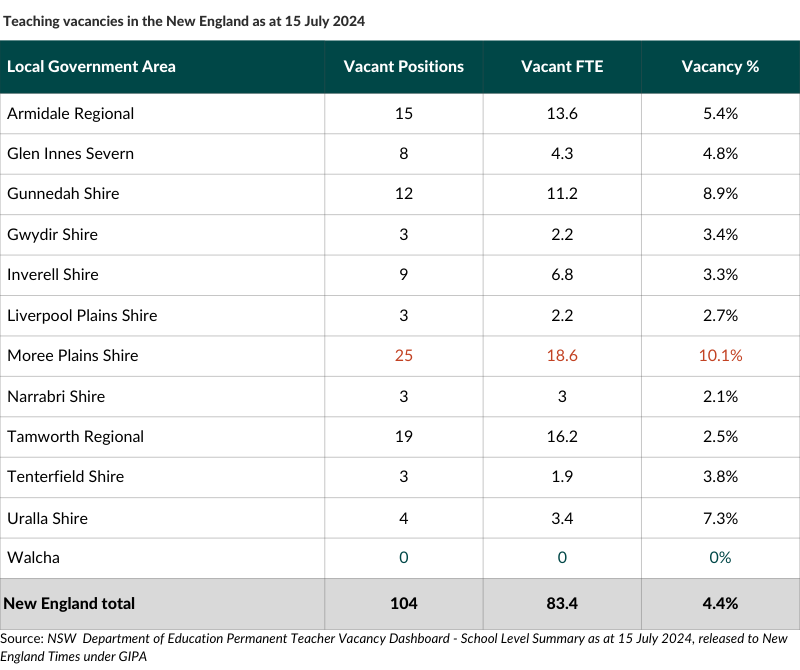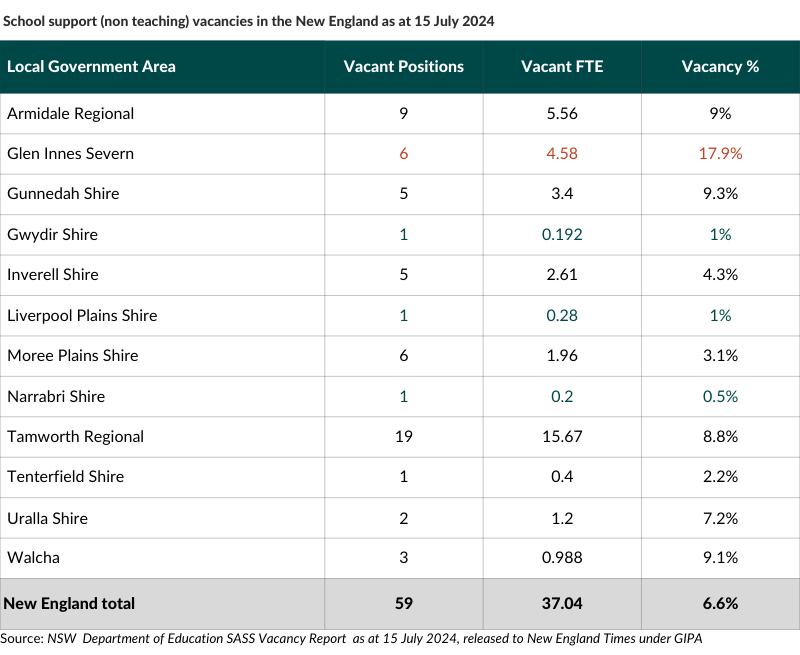
Data obtained from the NSW Department of Education exclusively by New England Times has revealed an alarmingly high level of vacant positions across schools in the New England.
As at the 15th of July, 104 teaching positions at New England Public Schools are vacant, equivalent to 83.4 full time faculty, or a vacancy rate of 4.4%. Additionally, there are 59 vacant non-teaching positions, equivalent to 37.04 full time staff, or 6.6% vacancy rate.
Gunnedah High has had a full time classroom teacher position vacant for more than 12 months, and Armidale Secondary College has had two full administrative positions (SAO) vacant for more than 12 months.
The data was requested from the Department under GIPA – the Government Information Public Access (GIPA) Act, which is the NSW equivalent of Freedom on Information – after a source claimed there was not a single school in the New England that was fully staffed. Our request for individual school figures was rejected.

Department denials continue
The initial response from the Department of Education to our inquiry in June, as is their custom, was dismissive, denying there was any problem, and asserting the opposite, claiming there were multiple schools in the region that were fully staffed, and that they were making good headway on the staffing issues at Armidale Secondary College.
“The College started receiving priority recruitment support in September 2023, when it had 7 permanent vacancies. Since then, 10 permanent appointments have been made,” the education spokesperson said.
“There are currently six positions being permanently recruited, including the principal position.”
“Classes are covered by temporary or casual staff when a permanent staff member is not available.”
A report late last year found that due to a widespread shortage of casual teaching staff, some classes were not being covered. Students and parents at ASC, as well as P&C minutes, revealed classes were not being covered during last year’s investigation into the trouble at ASC.
The Priority Recruitment Support program gives intensive recruitment assistance to schools with significant teacher staffing challenges. Long-standing vacancies at these schools can now be advertised with a recruitment bonus of up to $20,000, and a relocation support package of up to $8000 for eligible teachers. It is not restricted to regional and rural schools, with the department’s Job Feed website showing many schools in Sydney getting the same support.
No part of the New England unaffected
Armidale Secondary College continues to receive priority support, but it may not be the school in greatest need.
Moree schools are missing more than 10% of their teaching staff, with Gunnedah and Uralla close behind at 8.9% and 7.4% vacancy respectfully. Gunnedah’s 12 vacancies are a significant improvement from the 25 open roles at the beginning of the year, when it was reported that some 2000 teachers were needed statewide.

In support staff, Armidale, Gunnedah, Tamworth and Walcha are all around 9% vacancy, while Glen Innes is at a whopping 17.9% vacancy, or more than 1 in 6 desks sitting empty. While it is widely accepted that there is a shortage of teachers and a variety of incentives are offered to assist in teacher recruitment, it is not clear why there would be such a high vacancy rate amongst support staff.
There was no local government area that did not need staff of some kind. Walcha has its full complement of teachers, but has three support staff vacancies. Narrabri almost has all its support staff with just one 0.2FTE role (or one day a week) vacant, but needs three teachers. Liverpool Plains and Gwydir shires also had just one small admin role vacant, but needs three teachers.
Working on the problem
The NSW Teachers Federation pointed the finger at the previous government.
“The teacher shortage in the New England region is a direct consequence of the former Coalition state government’s relentless suppression of wages over the last decade,” Katie Sullivan, NSW Teachers Federation Country Organiser said.
“While the rebuild is underway, crushing workloads remain a huge problem in attracting and retaining the teachers our children need and deserve.”
The state MP representing the worst affected schools in the New England chose to respond to the figures with a more conciliatory tone.
“Whilst such high vacancy rates are alarming, I am open and willing to work with the Government to boost teacher numbers and ensure our kids have the best educational opportunities,” Member for Northern Tablelands Brendan Moylan said.
“It has become glaringly clear to me in the first month on the job, that staff shortages are a major concern across the Northern Tablelands, in almost every profession and trade.”
“In terms of the teacher vacancy rates I will be seeking to discuss this issue with the Minister for Education.”
The Minns Labor Government had made a number of pledges to fix the teacher shortage ahead of the election last year, and have delivered on some including a substantial pay rise.
Hope in changing training pathways
Hope may be coming from south of the border, where La Trobe University’s Nexus program is getting results.
Nexus, a first-of-its-kind and proven initiative, is an employment-based pathway to teaching that enables high-performing professionals to transition from other careers while gaining practical experience in school settings. Or more simply, they learn on the job, undertaking their degree while working in their school, negating the obstacle of having to earn a living elsewhere while studying.
Building on its success in Victoria, where 94 per cent of participants were teaching after graduating from the Nexus program, a new cohort of aspiring primary teachers will soon start their journey through Nexus in NSW schools facing critical staffing shortages.
La Trobe’s Vice-Chancellor Professor Theo Farrell said the expansion into NSW primary schools marked an important milestone in the University’s ongoing efforts to address teacher shortages and improve student outcomes.
“Since 2020, Nexus has been instrumental in preparing educators for regional, rural and hard-to-staff school environments through its innovative approach,” Professor Farrell said.
“By expanding into NSW primary schools, we are helping to ensure that every student in NSW and Victoria has equitable access to quality education, regardless of their background or location.”
Most of the program’s participants come from diverse professional backgrounds, including journalism and marketing, and STEM-related fields such as applied mathematics, agriculture, pharmacy and engineering.
The University of New England’s School of Education was contacted for comment on this story but did not respond by time of publication.
Like what you’re reading? Support New England Times by making a small contribution today and help us keep delivering local news paywall-free. Support now


